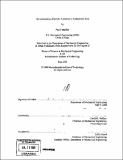| dc.contributor.advisor | David R. Wallace. | en_US |
| dc.contributor.author | Fathallah, Paul | en_US |
| dc.contributor.other | Massachusetts Institute of Technology. Dept. of Mechanical Engineering. | en_US |
| dc.date.accessioned | 2009-03-16T19:54:17Z | |
| dc.date.available | 2009-03-16T19:54:17Z | |
| dc.date.copyright | 2008 | en_US |
| dc.date.issued | 2008 | en_US |
| dc.identifier.uri | http://hdl.handle.net/1721.1/44873 | |
| dc.description | Thesis (S.M.)--Massachusetts Institute of Technology, Dept. of Mechanical Engineering, 2008. | en_US |
| dc.description | Includes bibliographical references (p. 72-73). | en_US |
| dc.description.abstract | The main objective of this research was to find ways to actuate animatronic toys quietly. A practical assessment was conducted to evaluate a variety of quieter actuation methods for animatronic toys for Hasbro®, the client. Also, an evaluation of acoustical enclosures was carried out to determine if they were an effective way to reduce the sound from gear-boxes and actuators that currently actuate the line of animatronic toys made by the client. Several actuation methods and enclosure materials were considered and evaluated based upon their performance, relative quietness, and their viability in the application into animatronic toys. Qualitative and quantitative comparisons were made of each of the actuation methods and were eliminated based upon their ability to satisfy the design constraints based upon their safety, acoustical performance, and ability to reproduce the life-like characteristics of the toys. Quantitative comparisons were made of each of the enclosure materials using a sound control box and a decibel meter to measure the output sound pressure level of each enclosure configuration. Among all the evaluated alternatives, from advanced actuation methods to acoustically attenuating enclosures, the acoustical enclosures performed the best. The acoustical performance rating of the polyurethane-neoprene based composite layering was far superior to the other materials tested, but was not the most economical of the acoustical enclosure materials. Acoustical enclosures can be implemented in the current line of animatronic toys and do not require any mold changes, modifications to the product architecture. Material acquisition and forming are the only steps needed to achieve the sound attenuation performance they effectively provide. | en_US |
| dc.description.statementofresponsibility | by Paul Fathallah. | en_US |
| dc.format.extent | 73 p. | en_US |
| dc.language.iso | eng | en_US |
| dc.publisher | Massachusetts Institute of Technology | en_US |
| dc.rights | M.I.T. theses are protected by
copyright. They may be viewed from this source for any purpose, but
reproduction or distribution in any format is prohibited without written
permission. See provided URL for inquiries about permission. | en_US |
| dc.rights.uri | http://dspace.mit.edu/handle/1721.1/7582 | en_US |
| dc.subject | Mechanical Engineering. | en_US |
| dc.title | The exploration of quieter actuation in animatronic toys | en_US |
| dc.type | Thesis | en_US |
| dc.description.degree | S.M. | en_US |
| dc.contributor.department | Massachusetts Institute of Technology. Department of Mechanical Engineering | |
| dc.identifier.oclc | 302278372 | en_US |
